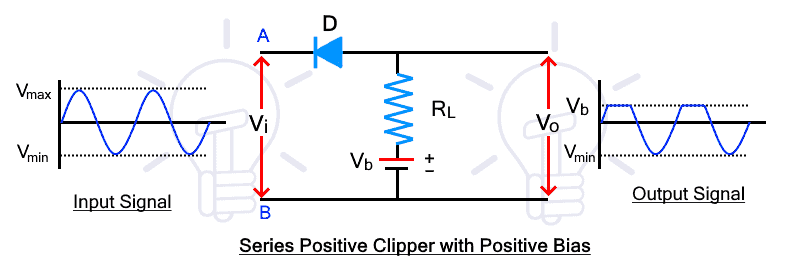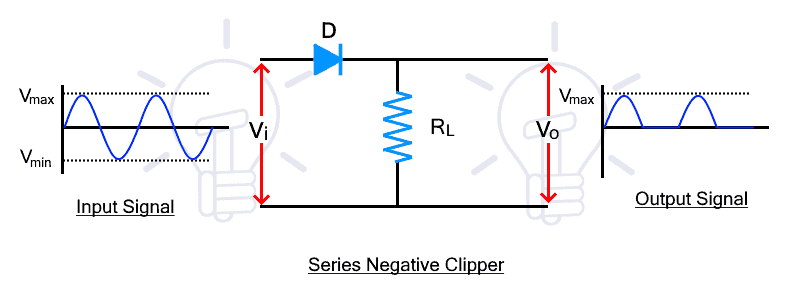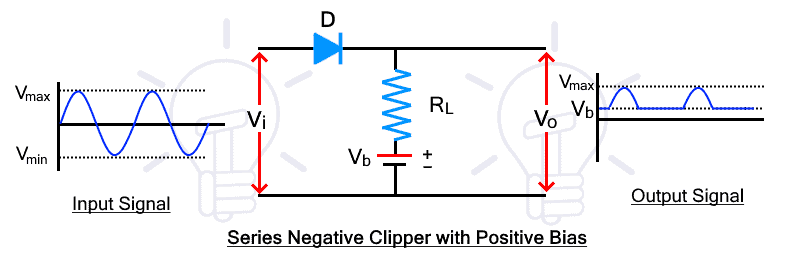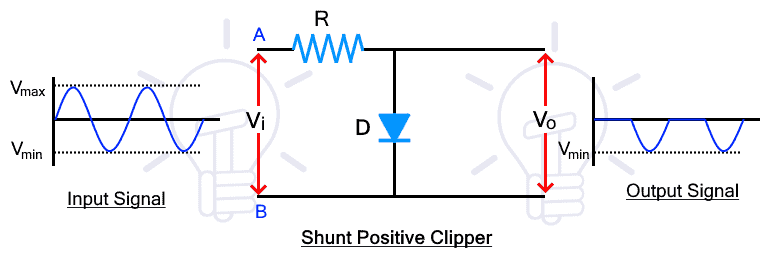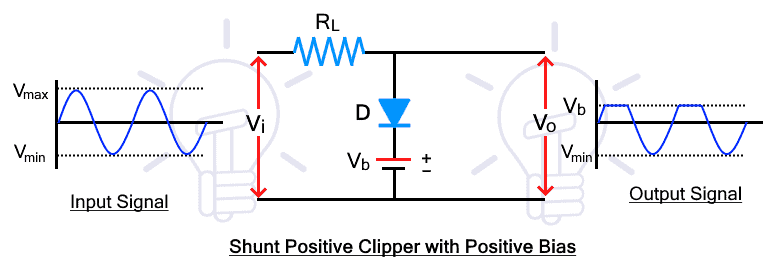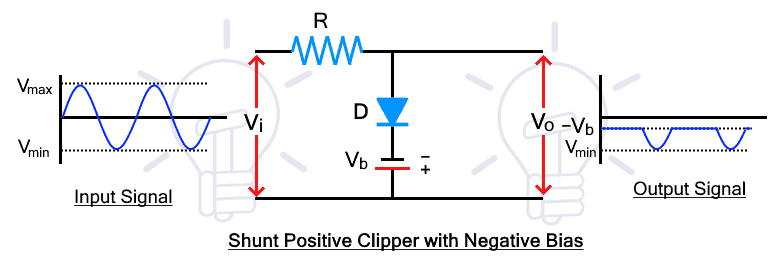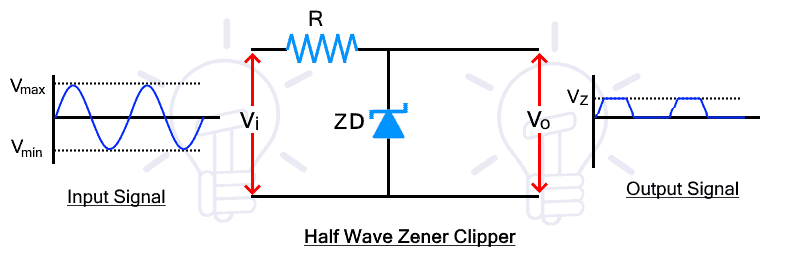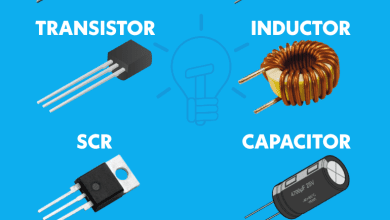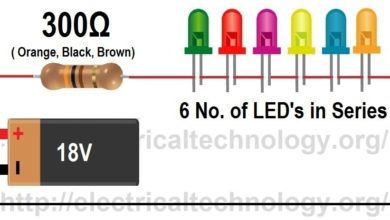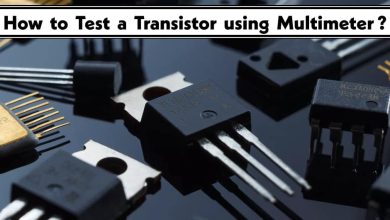Clipper Circuit – Types, Working and Applications
Types of Series, Shunt (Negative & Positive) and Dual or Combination Clippers
In electronics, there are different sensitive components or circuits whose operation depends on the waveform of the input signal. If the voltage rises above a limit, it may affect its operation and causes a problem in the circuit.
Most electronic circuits operate on a sinusoidal waveform. In order to avoid, the voltage rising above or below a certain limit, the remaining portion of the waveform is clipped. The clipper circuit uses such a method to prevent the voltage from rising above a certain limit.
Clipper Circuit
Clipper circuits are the electronic circuits that clip off or remove a portion of an AC signal, without causing any distortion to the remaining part of the waveform. These are also known as clippers, clipping circuits, limiters, slicers, etc
The main component of a clipper circuit is a diode or any other type of diode. The diode clips a portion from the input waveform. The shape of the waveform depends on the configuration as well as the design of the circuit. Therefore, there are different types of clipper circuits discussed below.
Related Posts:
- Clamper Circuit – Types, Working and Applications
- Main Difference Between Clipper and Clamper Circuit
Types of Clippers
The diode-based clipper circuit can be classified into the following two types.
- Series Diode Clippers
- Shunt Diode Clippers
Series Clippers
In series clipper circuits, the diode is connected in series with the output. In such clippers, the input signal appears at the output when the diode is forward biased and conducting. On the contrary, the shunt clippers passes the input signal when the diode is reverse biased or blocking.
It is divided into positive and negative clippers.
Series Positive Clippers
Series positive clippers remove or clips the positive half of the waveform. In a series positive clipper, the diode is in reverse biased and in series with the output as shown in the figure below.
The input signal Vi is applied at the input side while the output is taken at the load resistor. During the positive half cycle of the input, the voltage at point A is positive than point B. So the diode is in reverse bias and there is no current conduction. The input signal cannot pass, thus there is no voltage drop at the Rl. Therefore, there the positive half cycle does not appear at the output as shown in the figure.
During the negative half-cycle, the voltage at point A is negative than point B. The diode becomes forward bias and the signal pass through it. The signal appears across the Rl. Therefore, the negative half cycle passes through the circuit and appears at the output.
As illustrated in the given figure, it shows how it clips the positive half and allows the negative half of the input waveform.
Related Posts:
- Cuk Converter and How it Works? Circuit & Operation
- Buck Converter – Circuit, Design, Operation and Examples
- Boost Converter? Circuit Diagram and Working
Series Positive Clippers with Bias
The biasing in the clippers circuit is used to clip a portion of the half cycle and not the whole halve. Therefore, a series positive clipper with biasing which can be positive or negative is used for producing the desired waveforms.
Positive Bias
In such a positive clipper circuit, the positive of the battery is connected to the P side of the diode as shown in the figure below.
During the positive half cycle, the voltage at point A is greater than point B due to which, the diode is in reverse bias and switched off. But there is another voltage source whose positive is connected to the P-side of the diode. This voltage source or battery puts the diode in forward bias.
If the input voltage is less than the battery voltage, the diode remains in forward bias and it conducts. Therefore, the signal appears at the output. When the input voltage increases above the battery voltage, the diode becomes reverse-biased and does not conduct the input signal. Therefore, the battery voltage Vb appears at the output.
During the negative half cycle, the diode is forward biased due to the input voltage as well as the battery voltage. Therefore, the input signal passes through the diode and it appears at the output.
- Related Post: 12V to 5V Converter Circuit – Boost and Buck Converters
Negative Bias
The battery in the negative biased series positive clipper is connected in reverse with the diode as shown in the figure below.
During the positive half cycle, the diode is reversed biased due to the input voltage and the negative battery as well. Therefore, in the positive half cycle, the diode does not conduct and only the negative battery voltage appears at the output.
During the negative half-cycle, the input voltage polarity reverses and the diode becomes forward biased. However, the diode is reverse biased due to the negative battery. Therefore, the diode only becomes forward biased if the input voltage increases above the battery voltage and the input signal appear at the output. Otherwise, the negative battery voltage appears at the output.
Series Negative Clippers
The series negative clipper circuit clips the negative half of the input cycle. its circuit diagram is given below.
During positive half cycle, the diode is forward biased due to the input voltage. Therefore, the input signal passes through the diode and appears at the output.
During the negative half cycle, the diode becomes reverse-biased and it does not conduct. Therefore, there is no voltage at the output and the negative half cycle is clipped from the input waveform.
Related Posts:
- Analog to Digital Converter (ADC) – Block Diagram, Factors & Applications
- Digital to Analog Converter (DAC) – Types, Working & Applications
Series Negative Clippers with Bias
The series negative clipper is biased with either positive or negative voltage battery to modify the waveform instead of clipping the whole negative half.
Positive Bias
During the positive half cycle, the diode is forward biased due to input signal voltage. While it is reversed biased due to the battery voltage. the state of the diode depends on both the voltage sources. Therefore, the diode will be forward biased and conduct only if the input voltage is greater than the battery voltage.
At first, the input voltage is lower than battery voltage, therefore, the diode is reversed biased and does not conduct. So the battery voltage appears at the output. The input signal appears at the output for the portion when it becomes greater than the battery voltage as shown in the figure.
During the negative half of the cycle, the diode is reversed biased due to both the input voltage as well as the battery voltage. therefore, only battery voltage appears at the output for the whole negative half cycle.
Negative Bias
During the positive half cycle, the diode is forward biased due to both the input signal and the battery voltage. Therefore, the diode conducts the signal for the whole positive half cycle and it appears at the output as it is in the input.
During the negative half-cycle, the input voltage forces the diode in reverse bias but the battery voltage still forward biases the diode. During this whole cycle, the diode only conducts when the battery voltage exceeds the input voltage.
At first, the input voltage is less than the battery voltage, thus the diode conducts and the signal appears at the output. But when it exceeds the battery voltage, the diode blocks the input signal and the battery voltage starts to appear at the output as shown in the figure.
Related Posts:
- Basic Voltage Doubler Circuit Diagram using 555 Timer IC
- Dual Power Supply Circuit Diagram – 230VAC to ±12VDC
Shunt Clippers
In shunt clippers, the diode is connected in parallel with the output. The input signal appears the output when the diode is blocking as opposed to the series clippers.
The shunt clippers can also be divided into positive and negative clippers.
- Shunt Positive Clippers
- Shunt Negative Clippers
Shunt Positive Clippers
The shunt positive clipper clips the positive half cycle of the input waveform. The circuit diagram of the shunt positive clipper is given below.
During the positive half cycle, the diode is forward biased as the voltage at point A is greater than point B. so the diode conducts the input signal and there is no voltage difference at the output.
During the negative half-cycle, the voltage polarity of the input signal at points A and B reverses and the diode becomes reverse biased. Therefore, the diode blocks the input signal and the signal voltage appears across the diode that is taken as the output of the clipper.
In such a way, the shunt positive clippers, clips or remove, the positive half of the input cycle and allow the negative half cycle.
Shunt Positive Clippers with Bias
The biasing is done by using another fixed voltage source such as a battery inside the circuit to modify the waveform furthermore. The voltage source can be connected in either positive or negative biasing.
Positive Bias
During the positive half cycle, the diode is forward biased due to the input voltage. but it is reversed biased due to the battery voltage. The sum of both voltages will decide the state of the diode. If the input voltage is greater than the battery voltage, the diode will be forward biased otherwise it will remain in reverse bias.
At first, the input signal is less than the battery voltage, so the diode is reversed biased and the signal appears at the output. but when it exceeds the battery voltage, the diode starts conducting the signal and only the battery voltage starts to appear at the output.
During the negative half cycle, the diode is reversed biased due to both input voltage as well as battery voltage. Therefore, the input signal appears for the whole negative half-cycle at the output.
Negative Bias
During the positive half cycle, the diode is forward biased for both input signal and battery voltage. Therefore, the diode conducts for the whole cycle and only the battery voltage appears at the output.
During the negative half cycle, the diode is reversed biased for input signal and forward biased for battery voltage. The combined effect of both voltage sources decides the state of the diode. The diode is forward biased when the input voltage is less than the battery voltage.
At first, the input signal is less than the battery voltage, thus the diode is forward biased. Therefore, the battery voltage appears at the output. When the input voltage exceeds the battery voltage, the diode becomes reversed biased and the input signal starts to appear at the output as shown in the figure.
Shunt Negative Clippers
The shunt negative clipper clips the negative half of the input waveform. The circuit diagram is given below
During the positive half cycle, the diode is reversed biased, thus it blocks the signal that appears across it. therefore, the positive half also appears at the output.
During the negative half cycle, the diode is forward biased and it conducts the signal. Therefore, there is no voltage at the output for the negative half cycle. Thus the shunt negative clipper clips or removes the negative half of the input waveform.
Shunt Negative Clippers with Bias
To further modify the waveform of the shunt negative clipper, positive or negative biasing is used with it by connecting a battery source in one of the two ways called positive biasing and negative biasing. The waveform can be modified by varying the voltage of the battery.
Positive Bias
During the positive half cycle, the diode is reversed biased for input voltage but forward biased for battery voltage. So, the diode will be reversed biased only when the input voltage exceeds the battery voltage and then the input signal will appear at the output.
At first, the signal is less than the battery, so the diode is forward biased and it conducts the signal. Therefore, only the battery voltage appears at the output. but when the input signal exceeds the battery voltage, the diode becomes reversed biased and the signal appears at the output as shown in the figure.
During the negative half cycle, the diode is forward biased for both input signal and battery voltage. Therefore, the diode conducts and only the battery voltage appears at the output for the whole negative cycle.
Negative Bias
During the positive half cycle, the diode is reversed biased for both input and battery voltage. thus, the diode blocks the voltage and the signal appears at the output for the whole positive half cycle.
During the negative half cycle, the diode conducts when the input voltage exceeds the battery voltage. Therefore, when the voltage is less than the battery voltage, the diode blocks and the signal appears at the output. When the input voltage exceeds, the diode starts conduction and only the battery voltage appears at the output.
Related Posts:
Dual or Combination Clippers
Dual clipper or combination clipper can clip a portion off from both positive and negative half cycle of the waveform. Two diodes are connected in parallel to each other where each diode has a battery or voltage source in series that reverse biases the respective diode. Here is the circuit diagram of a combination clipper.
The circuit operates using a simple principle. If both diodes are reversed biased or if they do not conduct, the input signal would appear across the diode and also appears at the output. Now, if one of the diodes starts conduction, their respective battery voltage will start to appear at the output.
During the positive half cycle, the diode D1 is forward biased while the D2 is reversed biased for input voltage. But the diode D1 and D2 is reversed biased for the battery voltage VB1 and VB2 respectively.
During the positive half cycle, the diode D1 is forward biased for input voltage and reversed biased for battery voltage VB1. While the diode D2 is reverse biased for both the input voltage as well as the battery voltage VB2.
At first, the input voltage is less than the battery voltage VB1, thus the diode D1 is in reverse bias. while the diode D2 is already in reverse bias. therefore, the input signal appears at the output. when the input voltage exceeds the VB1, diode D1 starts conduction and battery voltage VB1 starts to appear at the output.
During the negative half cycle, the diode D1 is reversed biased due to both input voltage and battery voltage VB1. The diode D2 is forward biased due to input voltage but reversed biased due to battery voltage VB2.
At first, the input voltage is lower than the VB2, thus the diode D2 is reversed biased and it does not conduct. The diode D1 is already in reverse bias. Therefore, the input signal appears at the output. When the input voltage exceeds the VB2, the diode starts conduction and the battery voltage VB2 appears at the output.
Using Zener Diode
A Zener diode is a special type of diode that not only conducts in forward direction (0.7v drop) but also in the reverse direction when the voltage exceeds Zener breakdown voltage. The reverse current flows while the voltage across it remains constant. Therefore, a Zener diode can act as a biased diode without using another biasing source.
Half Wave Zener Clipper
Here is the circuit diagram of the Zener diode clipper. During the positive half cycle, the diode is reversed biased for the input voltage. Therefore, the signal appears at the output. When the input voltage exceeds the Zener voltage, the Zener diode starts conduction and Zener voltage VZ starts to appear at the output.
During the negative half-cycle, the Zener diode is forward biased. Therefore, only the diode forward voltage drop (0.7v) appears at the output.
Full Wave Zener Clipper
Two Zener diodes can be used to clip portions from both halves of the input waveform. The Zener diodes are connected in reverse with each other as shown in the figure below.
During the positive half cycle, the Zener diode ZD1 is reverse-biased while the Zener diode ZD2 is forward biased. At first, the ZD1 diode does not allow the current. therefore, the signal appears at the output. But when the input voltage exceeds the Zener breakdown voltage, the Zener diode starts conduction and the Zener voltage Vz1 of the Zener diode ZD1 starts to appear at the output. Similarly, during the negative half cycle, the negative waveform is clipped after the Zener voltage of ZD2.
Applications of Clipper
The main purpose of the clipper circuit is to modify the waveform of the signal which can be used in several applications such as in protection against overvoltage, noise removal, transmission, etc.
- The clipper circuit offer overvoltage protection therefore, it is used in power supplies for limiting the voltage.
- They are used for filtering noise in transmitters.
- They are used in transmitters and receivers of television.
- They are used for modifying or generating new waveforms such as square, triangular, etc.
Related Posts:
- IGBT? Construction, Types, Working and Applications
- GTO? Types, Construction, Working and Applications
- TRIAC? Symbol, Construction, Working and Applications
- DIAC? Symbol, Construction, Working and Applications
- MOSFET – Working, Types, Operation, Advantages, and Applications
- Types of Transistors – BJT, FET, JFET, MOSFET, IGBT & Special Transistors

